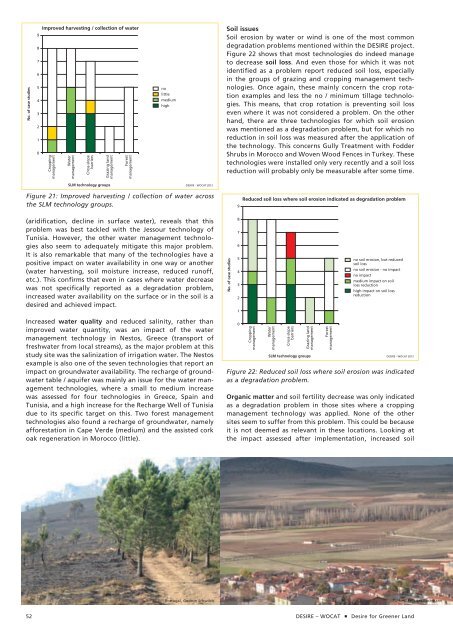Desire for Greener Land
Desire for Greener Land
Desire for Greener Land
You also want an ePaper? Increase the reach of your titles
YUMPU automatically turns print PDFs into web optimized ePapers that Google loves.
No. of case studies<br />
Improved harvesting / collection of water<br />
9<br />
8<br />
7<br />
6<br />
5<br />
4<br />
3<br />
2<br />
1<br />
0<br />
Cropping<br />
management<br />
Water<br />
management<br />
Cross-slope<br />
barriers<br />
Grazing land<br />
management<br />
SLM technology groups<br />
no<br />
little<br />
medium<br />
high<br />
(aridification, decline in surface water), reveals that this<br />
problem was best tackled with the Jessour technology of<br />
Tunisia. However, the other water management technologies<br />
also seem to adequately mitigate this major problem.<br />
It is also remarkable that many of the technologies have a<br />
positive impact on water availability in one way or another<br />
(water harvesting, soil moisture increase, reduced runoff,<br />
etc.). This confirms that even in cases where water decrease<br />
was not specifically reported as a degradation problem,<br />
increased water availability on the surface or in the soil is a<br />
desired and achieved impact.<br />
Increased water quality and reduced salinity, rather than<br />
improved water quantity, was an impact of the water<br />
management technology in Nestos, Greece (transport of<br />
freshwater from local streams), as the major problem at this<br />
study site was the salinization of irrigation water. The Nestos<br />
example is also one of the seven technologies that report an<br />
impact on groundwater availability. The recharge of groundwater<br />
table / aquifer was mainly an issue <strong>for</strong> the water management<br />
technologies, where a small to medium increase<br />
was assessed <strong>for</strong> four technologies in Greece, Spain and<br />
Tunisia, and a high increase <strong>for</strong> the Recharge Well of Tunisia<br />
due to its specific target on this. Two <strong>for</strong>est management<br />
technologies also found a recharge of groundwater, namely<br />
af<strong>for</strong>estation in Cape Verde (medium) and the assisted cork<br />
oak regeneration in Morocco (little).<br />
Forest<br />
management<br />
DESIRE - WOCAT 2012<br />
Figure 21: Improved harvesting / collection of water across<br />
the SLM technology groups.<br />
Soil issues<br />
Soil erosion by water or wind is one of the most common<br />
degradation problems mentioned within the DESIRE project.<br />
Figure 22 shows that most technologies do indeed manage<br />
to decrease soil loss. And even those <strong>for</strong> which it was not<br />
identified as a problem report reduced soil loss, especially<br />
in the groups of grazing and cropping management technologies.<br />
Once again, these mainly concern the crop rotation<br />
examples and less the no / minimum tillage technologies.<br />
This means, that crop rotation is preventing soil loss<br />
even where it was not considered a problem. On the other<br />
hand, there are three technologies <strong>for</strong> which soil erosion<br />
was mentioned as a degradation problem, but <strong>for</strong> which no<br />
reduction in soil loss was measured after the application of<br />
the technology. This concerns Gully Treatment with Fodder<br />
Shrubs in Morocco and Woven Wood Fences in Turkey. These<br />
technologies were installed only very recently and a soil loss<br />
reduction will probably only be measurable after some time.<br />
no soil erosion, but reduced<br />
soil loss<br />
no soil erosion - no impact<br />
no impact<br />
medium impact on soil<br />
loss reduction<br />
high impact on soil loss<br />
reduction<br />
Organic matter and soil fertility decrease was only indicated<br />
as a degradation problem in those sites where a cropping<br />
management technology was applied. None of the other<br />
sites seem to suffer from this problem. This could be because<br />
it is not deemed as relevant in these locations. Looking at<br />
the impact assessed after implementation, increased soil<br />
52 DESIRE – WOCAT <strong>Desire</strong> <strong>for</strong> <strong>Greener</strong> <strong>Land</strong><br />
No. of case studies<br />
Reduced soil loss where soil erosion indicated as degradation problem<br />
9<br />
8<br />
7<br />
6<br />
5<br />
4<br />
3<br />
2<br />
1<br />
0<br />
Cropping<br />
management<br />
Water<br />
management<br />
Cross-slope<br />
barriers<br />
Grazing land<br />
management<br />
SLM technology groups<br />
Forest<br />
management<br />
DESIRE - WOCAT 2012<br />
Figure 22: Reduced soil loss where soil erosion was indicated<br />
as a degradation problem.<br />
Portugal, Gudrun Schwilch Turkey, Felicitas Bachmann









